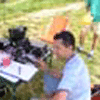PT0S — Sleeping Problems / Antenna Work http://pt0s.com/NEWSUPDATES.html + Log Updated http://pt0s.com/search.html + Stats http://www.twitlonger.com/show/k11n5m
Pilot station HA5X informs:"I have received a fresh news update from George. They suffer from lack of space, meaning they cannot sleep anywhere while operating day and night and doing maintenance work during the day."
Strong winds and large swells continue but the weather is fine otherwise. We are now running three stations during the day and two during the night.
The very limited Internet bandwidth is a major problem as we have trouble (and large expense) uploading the logs. Also, we do not have enough bandwidth (and time) to deal with individual log search requests. We intend to make log corrections once we are back on land, but until then the logs are as published. If you can not find your QSO in the log, please work us again: it will not be a dupe! Also, we are unable to upload pictures at this time.
Today we will do maintenance on the main (160 – 10) vertical, as a large wave has almost knocked it down during the night. Also, we need to move some of the RX antennas as the Brazilian Navy crew is doing their work on the structures we have attached them to. We are also working on a dedicated 10 m vertical to run on that band when 6 meters is not open.
Because of the lack of room, we do not have space to sleep during the day. Because of that, and the daytime workload, we are getting very tired. (I fell asleep at the key on 160 two or three times last night. Sorry if it caused any confusion.)
Low Bands: 160 was good last night. There was some QSB but not as bad as the night before. Also, the lightning crashes have moderated. Signals from both EU and NA have been most good, with some stations being extra loud. On the average, however, it still takes two to three tries to get a call complete. We made our first JA QSO this morning. The signals were extremely weak and the QSO was marginal, but we hope that this is a sign of improving conditions towards Asia. We will continue monitoring between 1822 and 1825 for JA and Asia, especially during possible openings.
80 meters has been be excellent. (Our 80 meter vertical, which stands almost all the time in a pool of salt-water, is perhaps our best performing antenna.) We have made a good number of JA contacts during the past few days.
40 meter signals have been extremely good.







![]() Totale pagine visualizzate: Visitatori
totali: Visitatori oggi:
Visitatori online:
Totale pagine visualizzate: Visitatori
totali: Visitatori oggi:
Visitatori online: 